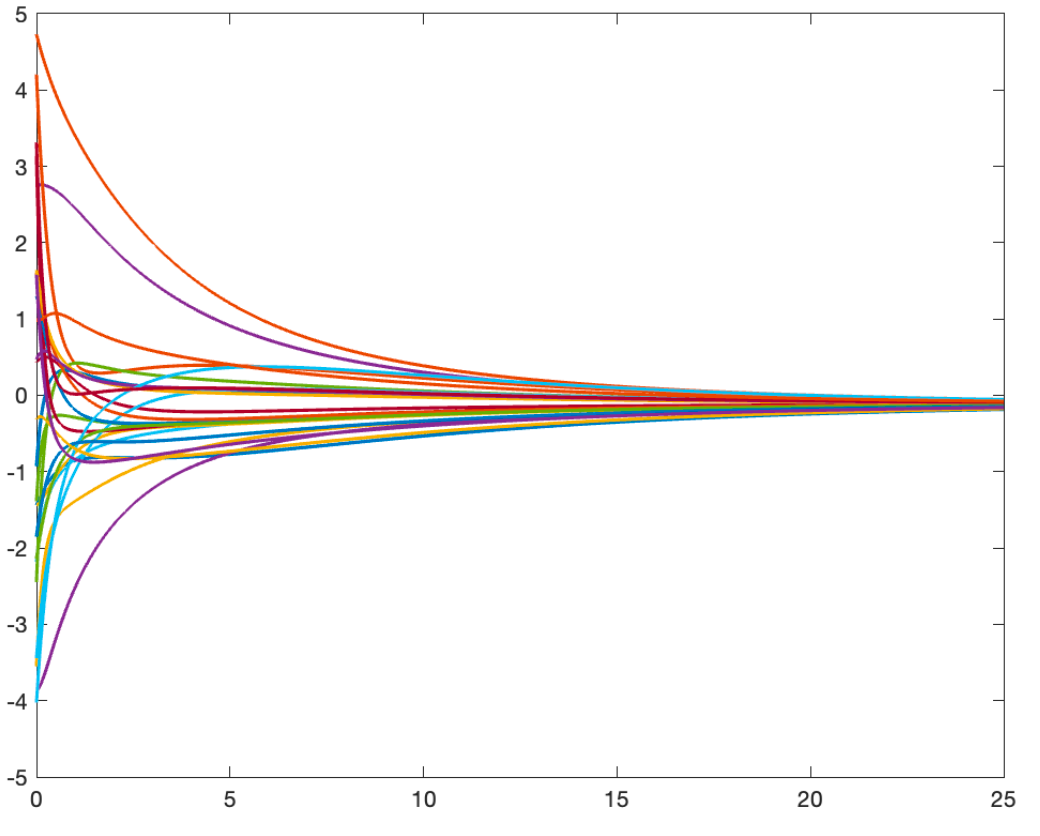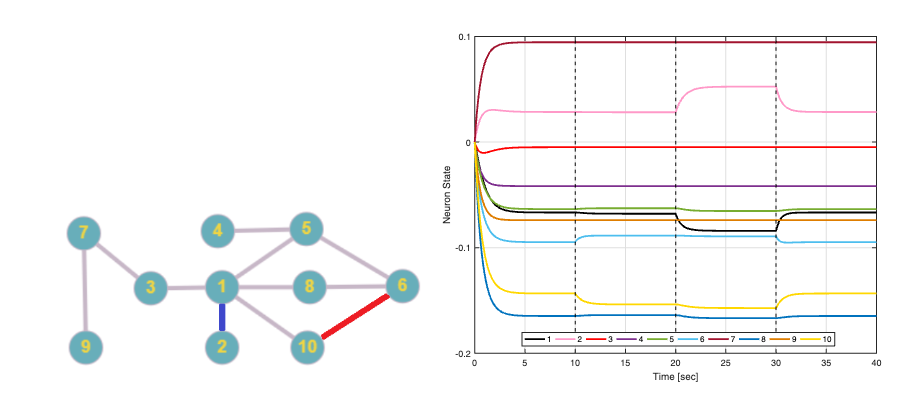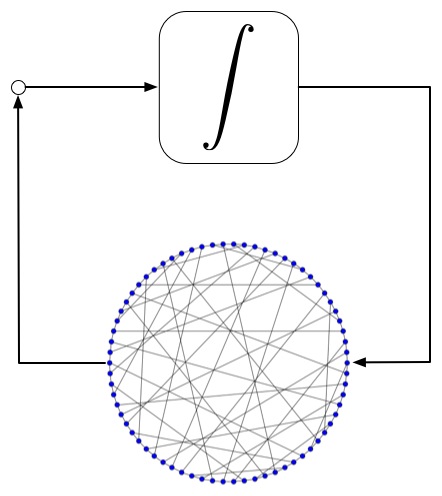Multi-agent systems are large-scale systems comprised of a group of coupled dynamic units, such as power generation sources in a power distribution network or a team of autonomous and unmanned vehicles. These systems interact via an exchange of information over a communication and sensing network. The complexity of this general class of problems arises from the heterogeneous dynamics of the systems comprising it, the diversity of interaction and communication mediums, and their scale in terms of the number of interacting systems and system interconnections. While research in this area is very active within the controls community, there remain many challenging and open problems that must be addressed before considering this a complete theory. The fundamental research questions we are looking at are:
- How does the underlying connection topology of networked dynamic systems affect its systems-theoretic properties?
- Can the connection topology be designed in conjunction with other synthesis techniques and tools used for dynamic systems?
We explore many different research questions in this area. Below is a sample of some of our contributions.
Consensus Algorithms
A fundamental task in many multi-agent coordination problems is the ability of the agents to distributedly agree on some quantity of interest. This may include agreeing on a common heading and speed for autonomous vehicles, opinions in social networks, or estimates of measured quantities. Our works have explored how the information exchange structure between agents influences the performance of these consensus algorithms.

Selected Publications:
- G. Barkai, L. Mirkin, and D. Zelazo, “On Sampled-Data Consensus: Divide and Concur,” IEEE Control Systems Letters, 6:343–348, 2022.
- D. Zelazo, M. Mesbahi, and M.-A. Belabbas, “Graph Theory in Systems and Controls,” in IEEE Conference on Decision and Control, Miami, Florida, Dec. 2018.
- M. H. Trinh, D. Zelazo, Q. V. Tran, and H.-S. Ahn, “Pointing Consensus for Rooted Out-Branching Graphs,” in American Control Conference, Milwaukee, WI, Jun. 2018.
- N. Leiter and D. Zelazo, “Graph-Based Model Reduction of the Controlled Consensus Protocol,” in IFAC World Congress, Toulouse, France, Jul. 2017.
- D. Zelazo, S. Schuler, and F. Allgöwer, “Performance and Design of Cycles in Consensus Networks,” Systems & Control Letters, 62(1):85–96, 2013.
- D. Zelazo and F. Allgöwer, “Eulerian Consensus Networks,” in 51st IEEE Conference on Decision and Control, Maui, HI, Dec. 2012.
- D. Zelazo and M. Mesbahi, “Edge Agreement: Graph-Theoretic Performance Bounds and Passivity Analysis,” IEEE Transactions on Automatic Control, 56(3):544–555, 2011.
- D. Zelazo, “Graph-theoretic Methods for the Analysis and Synthesis of Networked Dynamic Systems,” phdthesis, University of Washington, Department of Aeronautics & Astronautics, 2009.
Network Identification
Many large scale networks are often designed with hopes of plug-and-play behavior. In other applications, agents in a network may be vulnerable to attack or failure resulting in changes to the network structure and behavior. As a result, the network structure may not be known. It is of interest, therefore, to try to estimate or recover the network structure using only limited measurements from the network itself. This is known as the network identification problem.

Selected Publications:
- M. Sharf and D. Zelazo, “Network Identification for Diffusively-Coupled Networks with Minimal Time Complexity,” IEEE Transactions on Control of Network Systems, 10(3):1616–1628, 2023.
- D. Zelazo, M. Fabris, and L. Peled-Eitan, “Distributed Identification of Leader Agents in Semi-Autonomous Networks,” in 62nd Israel Annual Conference on Aerospace Sciences, Haifa, Israel, Mar. 2023.
- M. Sharf and D. Zelazo, “Monitoring Link Faults in Nonlinear Diffusively-coupled Networks,” IEEE Transactions on Automatic Control, 67(6):2857–2872, 2022.
- M. Sharf and D. Zelazo, “Network Identification: A Passivity and Network Optimization Approach,” in IEEE Conference on Decision and Control, Miami, Florida, Dec. 2018.
All our publications in this area can be found below:
Related Publications:
- F. Yue and D. Zelazo, “A Passivity Analysis for Nonlinear Consensus
on Digraphs,” in IAAC3 Control Conference, Herzliya, Israel, Apr. 2025.
- E. Matmon and D. Zelazo, “Leader Identification in Semi-Autonomous Consensus Protocols,” in IAAC3 Control Conference, Herzliya, Israel, Apr. 2025.
- G. Barkai and D. Zelazo, “On Filtered Consensus Protocols,” in IAAC3 Control Conference, Herzliya, Israel, Apr. 2025.
- M. Sharf and D. Zelazo, “Cluster assignment in multi-agent systems: Sparsity bounds and fault tolerance,” Asian Journal of Control, 27(1):63–75, 2025.
- G. Barkai, L. Mirkin, and D. Zelazo, “Asynchronous Sampled-Data Synchronization with Small Communications Delays,” in IEEE Conference on Decision and Control, Milan, Italy, Dec. 2024.
- G. Barkai, L. Mirkin, and D. Zelazo, “An Emulation Approach to Output-Feedback Sampled-Data Synchronization,” in European Control Conference, Stockholm, Sweden, Jun. 2024.
- J. Shi and D. Zelazo, “Bearing-only Formation Control with Directed Sensing,” in 63rd Israel Annual Conference on Aerospace Sciences, Haifa, Israel, May 2024.
- J. Attias, Y. Marciano, R. Arhipov, and D. Zelazo, “An Open Source Quadcopter Platform for Simulink,” in 63rd Israel Annual Conference on Aerospace Sciences, Haifa, Israel, May 2024.
- F. Yue and D. Zelazo, “Diodes and the Importance of Network Orientations in Diffusively-Coupled Networks,” in 63rd Israel Annual Conference on Aerospace Sciences, Haifa, Israel, May 2024.
- G. Barkai, L. Mirkin, and D. Zelazo, “Asynchronous Sampled-Data Synchronization with Small communication Delays,” in 63rd Israel Annual Conference on Aerospace Sciences, Haifa, Israel, May 2024.
- F. Yue and D. Zelazo, “A Passivity Analysis for Nonlinear Consensus
on Balanced Digraphs,” 2024.
- G. Barkai, L. Mirkin, and D. Zelazo, “An emulation approach to sampled-data synchronization,” in IEEE Conference on Decision and Control, Singapore, Dec. 2023.
- G. Barkai, L. Mirkin, and D. Zelazo, “On the internal stability of diffusively coupled multi-agent systems and the dangers of cancel culture,” Automatica, 155:111158, 2023.
- M. Sharf and D. Zelazo, “Network Identification for Diffusively-Coupled Networks with Minimal Time Complexity,” IEEE Transactions on Control of Network Systems, 10(3):1616–1628, 2023.
- M.-A. Belabbas, X. Chen, and D. Zelazo, “On Structural Rank and Resilience of Sparsity Patterns,” IEEE Transactions on Automatic Control, 68(8):4783–4795, 2023.
- A. Priel and D. Zelazo, “Event-triggered consensus Kalman filtering for time-varying networks and intermittent observations,” International Journal of Robust and Nonlinear Control, 33(13):7430–7451, 2023.
- D. Zelazo, M. Fabris, and L. Peled-Eitan, “Distributed Identification of Leader Agents in Semi-Autonomous Networks,” in 62nd Israel Annual Conference on Aerospace Sciences, Haifa, Israel, Mar. 2023.
- M. Fabris and D. Zelazo, “A Robustness Analysis to Structured Channel Tampering Over Secure-by-Design Consensus Networks,” IEEE Control Systems Letters, 7:2011–2016, 2023.
- G. Barkai, L. Mirkin, and D. Zelazo, “On Internal Stability of Diffusive-Coupling and the Dangers of Cancel Culture,” in 25th International Symposium on Mathematical Theory of Networks and Systems, Germany, Sep. 2022.
- M. Fabris and D. Zelazo, “Secure Consensus via Objective Coding: Robustness Analysis to Channel Tampering,” IEEE Transactions on Systems, Man and Cybernetics: Systems, 52(12):7885–7897, 2022.
- M. Sharf and D. Zelazo, “Monitoring Link Faults in Nonlinear Diffusively-coupled Networks,” IEEE Transactions on Automatic Control, 67(6):2857–2872, 2022.
- M. Sharf and D. Zelazo, “Cluster Assignment in Multi-Agent Systems,” in The 13th Asian Control Conference, Jeju Island, South Korea, May 2022.
- M. Sharf, A. Romer, D. Zelazo, and F. Allgower, “Model-Free Practical Cooperative Control for Diffusively Coupled Systems,” IEEE Transactions on Automatic Control, 67(2):754–766, 2022.
- G. Barkai, L. Mirkin, and D. Zelazo, “On Sampled-Data Consensus: Divide and Concur,” IEEE Control Systems Letters, 6:343–348, 2022.
- N. Leiter, “Graph-based Model Reduction Methods for Multi-Agent Systems,” phdthesis, Technion - Israel Institute of Technology, Aerospace Engineering Department, 2022.
- A. Priel, “Consensus Kalman Filtering: Filter Design and Event-Triggering,” mastersthesis, Technion - Israel Institute of Technology, Aerospace Engineering Department, 2022.
- A. Priel and D. Zelazo, “An Improved Distributed Consensus Kalman Filter Design Approach,” in IEEE Conference on Decision and Control, Austin, Texas, Dec. 2021.
- M. Sharf, A. Jain, and D. Zelazo, “Geometric Method for Passivation and Cooperative Control of Equilibrium-Independent Passive-Short Systems,” IEEE Transactions on Automatic Control, 66(12):5877–5892, 2021.
- N. Leiter and D. Zelazo, “Edge-matching graph contractions and their interlacing properties,” Linear Algebra and its Applications, 612:289–317, 2021.
- N. Leiter and D. Zelazo, “Product Form of Projection-Based Model Reduction and its Application to Multi-Agent Systems,” 2021.
- H. Chen, D. Zelazo, X. Wang, and L. Shen, “Convergence Analysis of Signed Nonlinear Networks,” IEEE Transactions on Control of Network Systems, 7(1):189–200, 2020.
- M. Sharf, “Network Optimization Methods in Passivity-Based Cooperative Control,” phdthesis, Technion - Israel Institute of Technology, Aerospace Engineering Department, 2020.
- Y. Palti, “Deployment Strategies for Coverage Control Problems,” mastersthesis, Technion - Israel Institute of Technology, Aerospace Engineering Department, 2020.
- D. Mukherjee and D. Zelazo, “Robustness of Consensus over Weighted Digraphs,” IEEE Transactions on Network Sciences and Engineering, 6(4):657–670, 2019.
- D. Mukherjee and D. Zelazo, “Consensus of Higher Order Agents: Robustness and Heterogeneity,” IEEE Transactions on Control of Network Systems, 6(4):1323–1333, 2019.
- M. Sharf and D. Zelazo, “Analysis and Synthesis of MIMO Multi-Agent Systems Using Network Optimization,” IEEE Transactions on Automatic Control, 64(11):1558–2523, 2019.
- M. Sharf and D. Zelazo, “Symmetry-Induced Clustering in Multi-Agent Systems using Network Optimization and Passivity,” in 27th Mediterranean Conference on Control and Automation, Akko, Israel, Jul. 2019.
- M. Sharf and D. Zelazo, “Network Feedback Passivation of Passivity-Short Multi-Agent Systems,” IEEE Control Systems Letters, 3(3):607–612, 2019.
- Y. Palti and D. Zelazo, “A Projected Lloyd’s Algorithm for Coverage Control Problems,” in 59th Israel Annual Conference on Aerospace Sciences, Haifa, Israel, Mar. 2019.
- D. Zelazo, M. Mesbahi, and M.-A. Belabbas, “Graph Theory in Systems and Controls,” in IEEE Conference on Decision and Control, Miami, Florida, Dec. 2018.
- A. Jain, M. Sharf, and D. Zelazo, “Regularization and Feedback Passivation in Cooperative Control of Passivity-Short Systems: A Network Optimization Perspective,” IEEE Control Systems Letters, 2(4):731–736, 2018.
- M. H. Trinh, D. Zelazo, Q. V. Tran, and H.-S. Ahn, “Pointing Consensus for Rooted Out-Branching Graphs,” in American Control Conference, Milwaukee, WI, Jun. 2018.
- N. Leiter and D. Zelazo, “The Aggregating Consensus Protocol: A Case Study of Behavioral Multi-Agent Systems,” in 58th Israel Annual Conference on Aerospace Sciences, Haifa, Israel, Feb. 2018.
- D. Mukherjee and D. Zelazo, “Robust Consensus of Higher Order Agents over Cycle
Graphs,” in 58th Israel Annual Conference on Aerospace Sciences, Haifa, Israel, Feb. 2018.
- N. Leiter and D. Zelazo, “Graph-Based Model Reduction of the Controlled Consensus Protocol,” in IFAC World Congress, Toulouse, France, Jul. 2017.
- M. Sharf and D. Zelazo, “A Network Optimization Approach to Cooperative Control Synthesis,” IEEE Control Systems Letters, 1(1):86–91, 2017.
- D. Zelazo and M. Bürger, “On the Robustness of Uncertain Consensus Networks,” IEEE Transactions on Control of Network Systems, 4(2):170–178, 2017.
- Y. Ben Shoushan and D. Zelazo, “Negotiation Between Dynamical Systems with Connectivity Constraints,” in 57th Israel Annual Conference on Aerospace Sciences , Tel-Aviv, Israel, Feb. 2017.
- Y. Ben-Shoushan, “Negotiation between Dynamical Systems with Connectivity Constraints,” mastersthesis, Technion - Israel Institute of Technology, Aerospace Engineering Department, 2017.
- D. Mukherjee and D. Zelazo, “Consensus Over Weighted Digraphs: A Robustness Perspective,” in 55th IEEE Conference on Decision and Control, Las Vegas, Nevada, Dec. 2016.
- D. Mukherjee and D. Zelazo, “Robust Consensus of Higher Order Agents over Cycle Graphs,” in 56th Israel Annual Conference on Aerospace Sciences, Haifa, Israel, Mar. 2016.
- D. Zelazo and M. Bürger, “On the Definiteness of the Weighted Laplacian and its Connection to Effective Resistance,” in 53rd IEEE Conference on Decision and Control, Los Angeles, CA, Dec. 2014.
- M. Bürger, D. Zelazo, and F. Allgöwer, “On the Steady-State Inverse-Optimality of Passivity-Based Cooperative Control,” in 4th IFAC Workshop on Distributed Estimation and Control in Networked System, Koblenz, Germany, Sep. 2013.
- S. Schuler, D. Zelazo, and F. Allgöwer, “Robust Design of Sparse Relative Sensing Networks,” in European Control Conference, Zürich, Switzerland, Jul. 2013.
- M. Bürger, D. Zelazo, and F. Allgöwer, “Hierarchical Clustering of Dynamical Networks Using a Saddle-Point Analysis,” IEEE Transactions on Automatic Control, 58(1):113–124, 2013.
- D. Zelazo, S. Schuler, and F. Allgöwer, “Performance and Design of Cycles in Consensus Networks,” Systems & Control Letters, 62(1):85–96, 2013.
- S. Schuler, D. Zelazo, and F. Allgöwer, “Design of sparse relative sensing networks,” in 51st IEEE Conference on Decision and Control, Maui, HI, Dec. 2012.
- D. Zelazo and F. Allgöwer, “Eulerian Consensus Networks,” in 51st IEEE Conference on Decision and Control, Maui, HI, Dec. 2012.
- M. Bürger, D. Zelazo, and F. Allgöwer, “Combinatorial Insights and Robustness Analysis for Clustering in Dynamic Networks,” in American Control Conference, Montreal, Canada, Jul. 2012.
- D. Zelazo, S. Schuler, and F. Allgöwer, “Cycles and Sparse Design of Consensus Networks,” in 51st IEEE Conference on Decision and Control, Maui, HI, 2012.
- B. Briegel, D. Zelazo, M. Bürger, and F. Allgöwer, “On the Zeros of Consensus Networks,” in 50th IEEE Conference on Decision and Control and European Control Conference, Orlando, FL, Dec. 2011.
- M. Bürger, D. Zelazo, and F. Allgöwer, “Network clustering: A dynamical systems and saddle-point perspective,” in 50th IEEE Conference on Decision and Control and European Control Conference, Orlando, FL, Dec. 2011.
- D. Zelazo, M. Bürger, and F. Allgöwer, “A Distributed Real-Time Algorithm for Preference-Based Agreement,” in Proc. 18th IFAC World Congress, Milan, Italy, Aug. 2011.
- D. Zelazo and M. Mesbahi, “Graph-Theoretic Analysis and Synthesis of Relative Sensing Networks,” IEEE Transactions on Automatic Control, 56(5):971–982, 2011.
- D. Zelazo and M. Mesbahi, “Edge Agreement: Graph-Theoretic Performance Bounds and Passivity Analysis,” IEEE Transactions on Automatic Control, 56(3):544–555, 2011.
- D. Zelazo and M. Mesbahi, “\mathcalH_∞ Performance and Robust Topology Design of Relative Sensing Networks,” in American Control Conference, Baltimore, MD, Jul. 2010.
- D. Zelazo and M. Mesbahi, “Graph-Theoretic Methods for Networked Dynamic Systems: Heterogeneity and H2 Performance,” in Efficient Modeling and Control of Large-Scale Systems, J. Mohammadpour and K. M. Grigoriadis, Eds. Boston, MA: Springer US, 2010, pp. 219–249.
- D. Zelazo and M. Mesbahi, “\mathcalH_2 Performance of Agreement Protocol with Noise: An Edge Based Approach,” in 48th IEEE Conference on Decision and Control and 28th Chinese Control Conference, Shanghai, China, Dec. 2009.
- D. Zelazo and M. Mesbahi, “\mathcalH_2 Analysis and Synthesis of Networked Dynamic Systems,” in American Control Conference, St. Louis, MO, Jun. 2009.
- D. Zelazo and M. Mesbahi, “\mathcalH_2 Performance of Relative Sensing Networks: Analysis and Synthesis,” in AIAA Infotech@Aerospace Conference and AIAA Unmanned ...Unlimited Conference, Seattle, WA, Apr. 2009, no. 7.
- D. Zelazo, “Graph-theoretic Methods for the Analysis and Synthesis of Networked Dynamic Systems,” phdthesis, University of Washington, Department of Aeronautics & Astronautics, 2009.
- D. Zelazo, A. Rahmani, J. Sandhu, and M. Mesbahi, “Decentralized Formation Control via the Edge Laplacian,” in American Control Conference, Seattle, WA, Jun. 2008.




